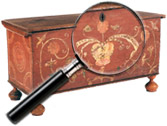|
|
Chinese Nichols Rugs
The Western demand for Chinese rugs began with an 1880 exhibition of Chinese rugs in Germany. In 1903 the new style Chinese rugs won first prize at the St. Louis International Exhibition. These new rugs featured wool which was shinier and finer and had a much shorter clip than traditional Chinese rugs.
Rugs in the Art Deco style were made from about 1910 to the late 1940′s. This “New Chinese Style” [...] Click here to continue reading.
Ambrosius Lamm, Dresden China Producer
The German Saxony capital of Dresden reached its peak as a center for producing fine hand-painted china in the century from 1850 to 1950 when over 200 decorating studios were in operation. This artistic outpouring had its origins in the nineteenth century’s translation of the earlier fashionable rococo period into a broad romantic movement expanding on themes of lush naturalism, beauty and love.
The firm of A. Lamm, located [...] Click here to continue reading.
Tunbridge Wares
The wood parquetry or marquetry decorated wares bearing this name derive from the small town of Tunbridge Wells in the English shire of Kent where the process was first developed in the late seventeenth century.
A decoration of veneer found on small boxes, gameboards, picture frames and trays, the Tunbridge decoration was created when small sticks or strips of differently colored natural wood of six or so inches long were glued together [...] Click here to continue reading.
The John Geib Family of Musical Instrument Builders
The Geib family was one of New York’s most eminent nineteenth century firms in the piano business. Immigrating to New York in 1797, with his family of seven children, John Geib & Son are listed as organ makers in 1802. His twin sons, John and Adam Geib, began making pianofortes in Mount Vernon (New York) in 1805. After the death of their father, John, Adam, George, [...] Click here to continue reading.
Locke & Co. Porcelain
This porcelain was manufactured by Edward Locke at a small production facility he established in 1895 at Shrub Hill, Worcester in 1895. His wares closely followed the styles used at the Royal Worcester works. They included vases, potpourri bowls, urns and other decorative pieces, often with reticulated features. A pale yellow and/or buff ground was fequently used. Locke continued this operation into the 20th century when it was taken over [...] Click here to continue reading.
Slag Glass
Slag glass is defined as colored, opaque glass wih an altenate color swirled throughout giving the appearance of marbling. For this reason it is sometimes called marble or malachite or mosaic glass. Popular colors include butterscotch, green and purple. The name has been used by glass-makers only in recent times and is derived from the belief that the colors were acheived by adding “slag” from iron smelting works to the glass.
[...] Click here to continue reading.
Whites Utica Pottery
Noah White began making pottery for several local firms in Utica, New York, circa 1834, In 1839 he bought out one of these companies, the Addington Pottery, and began making stoneware with the mark “N. WHITE” with the help of his son Nicholas A. White. Another son, William, joined the pottery in 1843; both were made partners in 1849 when the firm became “N. WHITE AND SONS”. William White sold out [...] Click here to continue reading.
Moses Tyler & Charles Dillon Pottery
Moses Tyler moved from Massachusetts to Albany, New York in 1822 and set up a pottery on Washington Avenue. Some time between 1826 and 1834 he formed a partnership with John Dillon and moved the pottery down the street to what had been the Cushman Pottery. Tyler left the pottery in 1834 to work alone until he retired in 1840.
After Tyler’s departure Charles Dillon took Jacob Henry [...] Click here to continue reading.
Ruba Rombic Glass & Muncie Pottery
In 1927 Reuben Haley designed an Art Deco line of glassware called Ruba Rombic for the Consolidated Glass Company of Coraopolis, Pennsylvania. This art glass line was introduced to the trade in January 1928 at the annual industry show at the Fort Pitt Hotel in Pittsburgh. Consolidated produced all the Ruba Rombic wares except for a very rare fish bowl produced by the Phoenix Glass Co.
All Ruba [...] Click here to continue reading.
Hubley Manufacturing
Founded in 1894, the Hubley Manufacturing Company began production of paperweights modeled after their famous cast iron banks after WWII. These replicas are greatly sought after by today’s collectors.
|
Recent Articles
- Charles Alfred Meurer – American Artist & Tromp L’Oeil Artist
- Sendak, Maurice – American Artist & Writer
- Godie, Lee – American Artist
- Davis, Vestie – American Artist
- Bartlett, Morton – American Artist
- Mackintosh, Dwight – American Artist
- Evans, Minnie Jones – African-American Artist
- Mumma, Ed (Mr. Eddy) – American Artist
- Nice, Don – American Artist
- Savitsky, John (Jack) – American Artist
- Gordon, Harold Theodore (Ted) – American Artist
- Dial, Thornton – African-American Artist
- Doyle Sam – American Artist
- Johnson, Lester Frederick – American Artist
- Finster, Howard – American Artist
|
|
